Report: Critical Appraisal of Health Economics Intervention Study
VerifiedAdded on 2022/11/28
|11
|3310
|216
Report
AI Summary
This report presents a critical appraisal of a health economics study concerning interventions for children with neurodevelopmental disorders. The analysis utilizes the Drummond 10-question checklist to evaluate the study's strengths and weaknesses, including its handling of research questions, alternative comparisons, and cost considerations. The report identifies the strengths such as effective evaluation of interventions and comparison of different alternatives. Also, the report highlights the study's weaknesses, such as the lack of operational and capital costs. The report further compares the study's findings with another relevant study, demonstrating the synthesis of evidence. The report concludes with recommendations based on the critical evaluation of economic principles, theories, and models such as scarcity and opportunity cost, relevant to healthcare interventions. The report also provides recommendations by critical evaluation of factors like equality, effectiveness, cost consequences, and measurement of cost. The student has provided a detailed analysis of the study's methodology, results, and implications for healthcare practice, offering insights into the economic evaluation of interventions for children with neurodevelopmental disorders.
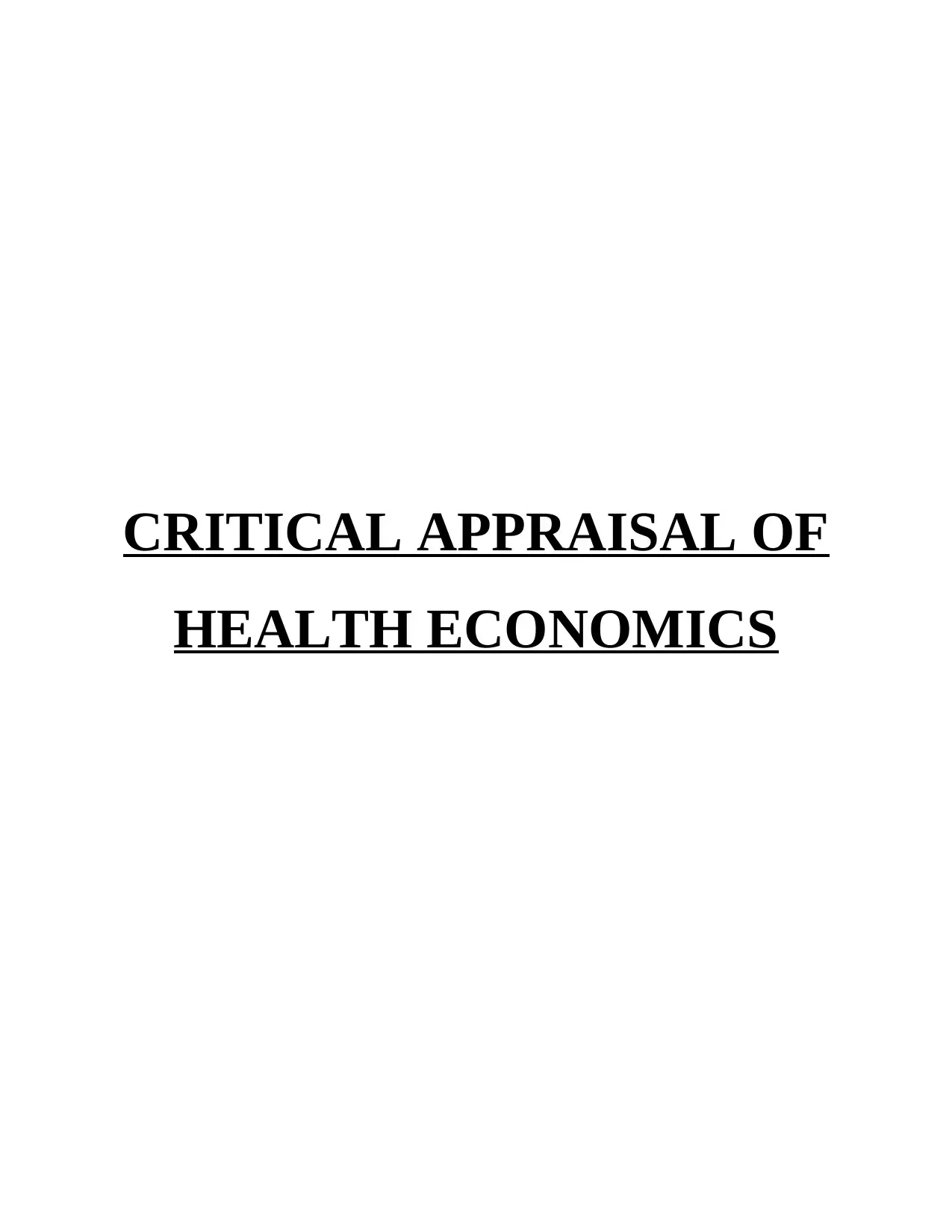
CRITICAL APPRAISAL OF
HEALTH ECONOMICS
HEALTH ECONOMICS
Paraphrase This Document
Need a fresh take? Get an instant paraphrase of this document with our AI Paraphraser
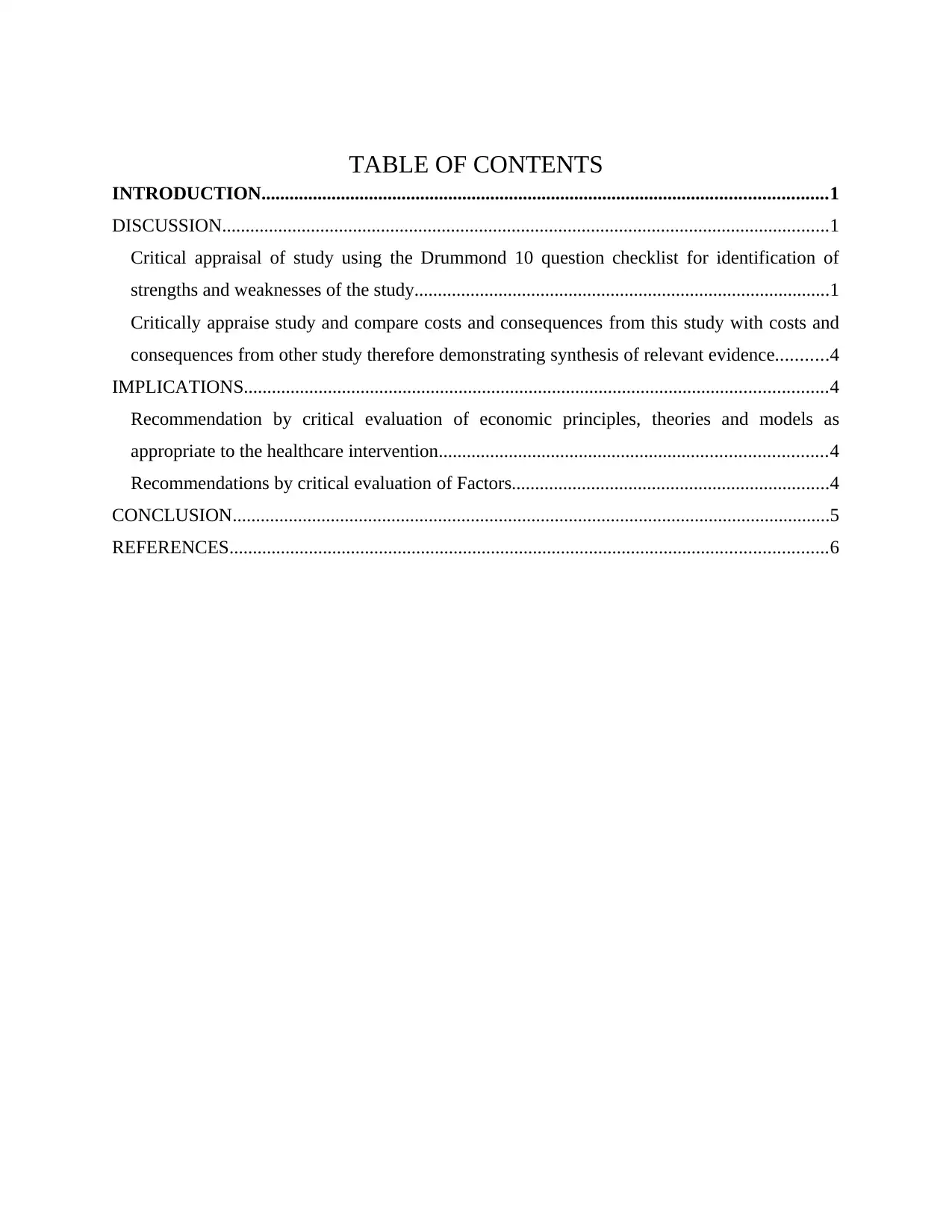
TABLE OF CONTENTS
INTRODUCTION.........................................................................................................................1
DISCUSSION..................................................................................................................................1
Critical appraisal of study using the Drummond 10 question checklist for identification of
strengths and weaknesses of the study.........................................................................................1
Critically appraise study and compare costs and consequences from this study with costs and
consequences from other study therefore demonstrating synthesis of relevant evidence...........4
IMPLICATIONS.............................................................................................................................4
Recommendation by critical evaluation of economic principles, theories and models as
appropriate to the healthcare intervention...................................................................................4
Recommendations by critical evaluation of Factors....................................................................4
CONCLUSION................................................................................................................................5
REFERENCES................................................................................................................................6
INTRODUCTION.........................................................................................................................1
DISCUSSION..................................................................................................................................1
Critical appraisal of study using the Drummond 10 question checklist for identification of
strengths and weaknesses of the study.........................................................................................1
Critically appraise study and compare costs and consequences from this study with costs and
consequences from other study therefore demonstrating synthesis of relevant evidence...........4
IMPLICATIONS.............................................................................................................................4
Recommendation by critical evaluation of economic principles, theories and models as
appropriate to the healthcare intervention...................................................................................4
Recommendations by critical evaluation of Factors....................................................................4
CONCLUSION................................................................................................................................5
REFERENCES................................................................................................................................6
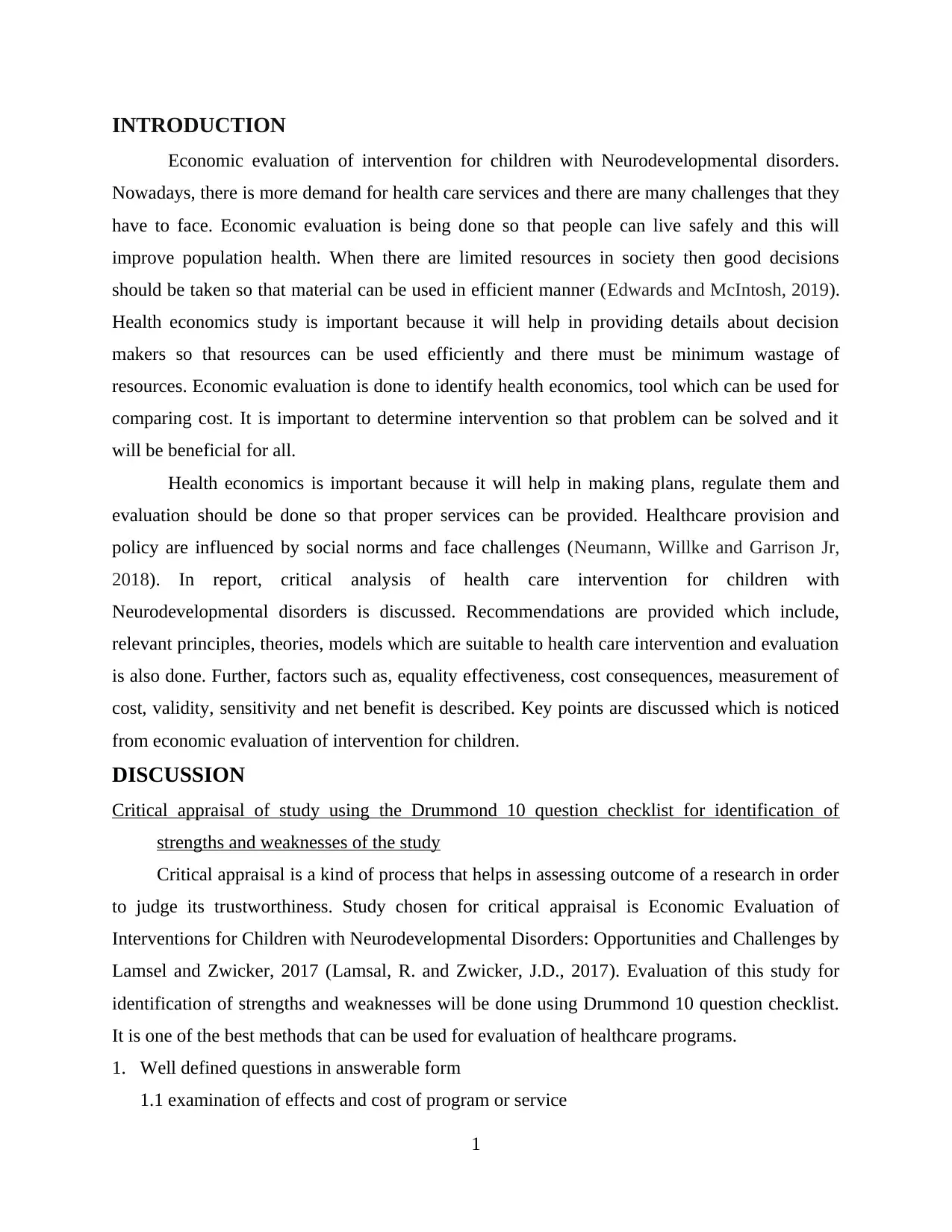
INTRODUCTION
Economic evaluation of intervention for children with Neurodevelopmental disorders.
Nowadays, there is more demand for health care services and there are many challenges that they
have to face. Economic evaluation is being done so that people can live safely and this will
improve population health. When there are limited resources in society then good decisions
should be taken so that material can be used in efficient manner (Edwards and McIntosh, 2019).
Health economics study is important because it will help in providing details about decision
makers so that resources can be used efficiently and there must be minimum wastage of
resources. Economic evaluation is done to identify health economics, tool which can be used for
comparing cost. It is important to determine intervention so that problem can be solved and it
will be beneficial for all.
Health economics is important because it will help in making plans, regulate them and
evaluation should be done so that proper services can be provided. Healthcare provision and
policy are influenced by social norms and face challenges (Neumann, Willke and Garrison Jr,
2018). In report, critical analysis of health care intervention for children with
Neurodevelopmental disorders is discussed. Recommendations are provided which include,
relevant principles, theories, models which are suitable to health care intervention and evaluation
is also done. Further, factors such as, equality effectiveness, cost consequences, measurement of
cost, validity, sensitivity and net benefit is described. Key points are discussed which is noticed
from economic evaluation of intervention for children.
DISCUSSION
Critical appraisal of study using the Drummond 10 question checklist for identification of
strengths and weaknesses of the study
Critical appraisal is a kind of process that helps in assessing outcome of a research in order
to judge its trustworthiness. Study chosen for critical appraisal is Economic Evaluation of
Interventions for Children with Neurodevelopmental Disorders: Opportunities and Challenges by
Lamsel and Zwicker, 2017 (Lamsal, R. and Zwicker, J.D., 2017). Evaluation of this study for
identification of strengths and weaknesses will be done using Drummond 10 question checklist.
It is one of the best methods that can be used for evaluation of healthcare programs.
1. Well defined questions in answerable form
1.1 examination of effects and cost of program or service
1
Economic evaluation of intervention for children with Neurodevelopmental disorders.
Nowadays, there is more demand for health care services and there are many challenges that they
have to face. Economic evaluation is being done so that people can live safely and this will
improve population health. When there are limited resources in society then good decisions
should be taken so that material can be used in efficient manner (Edwards and McIntosh, 2019).
Health economics study is important because it will help in providing details about decision
makers so that resources can be used efficiently and there must be minimum wastage of
resources. Economic evaluation is done to identify health economics, tool which can be used for
comparing cost. It is important to determine intervention so that problem can be solved and it
will be beneficial for all.
Health economics is important because it will help in making plans, regulate them and
evaluation should be done so that proper services can be provided. Healthcare provision and
policy are influenced by social norms and face challenges (Neumann, Willke and Garrison Jr,
2018). In report, critical analysis of health care intervention for children with
Neurodevelopmental disorders is discussed. Recommendations are provided which include,
relevant principles, theories, models which are suitable to health care intervention and evaluation
is also done. Further, factors such as, equality effectiveness, cost consequences, measurement of
cost, validity, sensitivity and net benefit is described. Key points are discussed which is noticed
from economic evaluation of intervention for children.
DISCUSSION
Critical appraisal of study using the Drummond 10 question checklist for identification of
strengths and weaknesses of the study
Critical appraisal is a kind of process that helps in assessing outcome of a research in order
to judge its trustworthiness. Study chosen for critical appraisal is Economic Evaluation of
Interventions for Children with Neurodevelopmental Disorders: Opportunities and Challenges by
Lamsel and Zwicker, 2017 (Lamsal, R. and Zwicker, J.D., 2017). Evaluation of this study for
identification of strengths and weaknesses will be done using Drummond 10 question checklist.
It is one of the best methods that can be used for evaluation of healthcare programs.
1. Well defined questions in answerable form
1.1 examination of effects and cost of program or service
1
⊘ This is a preview!⊘
Do you want full access?
Subscribe today to unlock all pages.

Trusted by 1+ million students worldwide
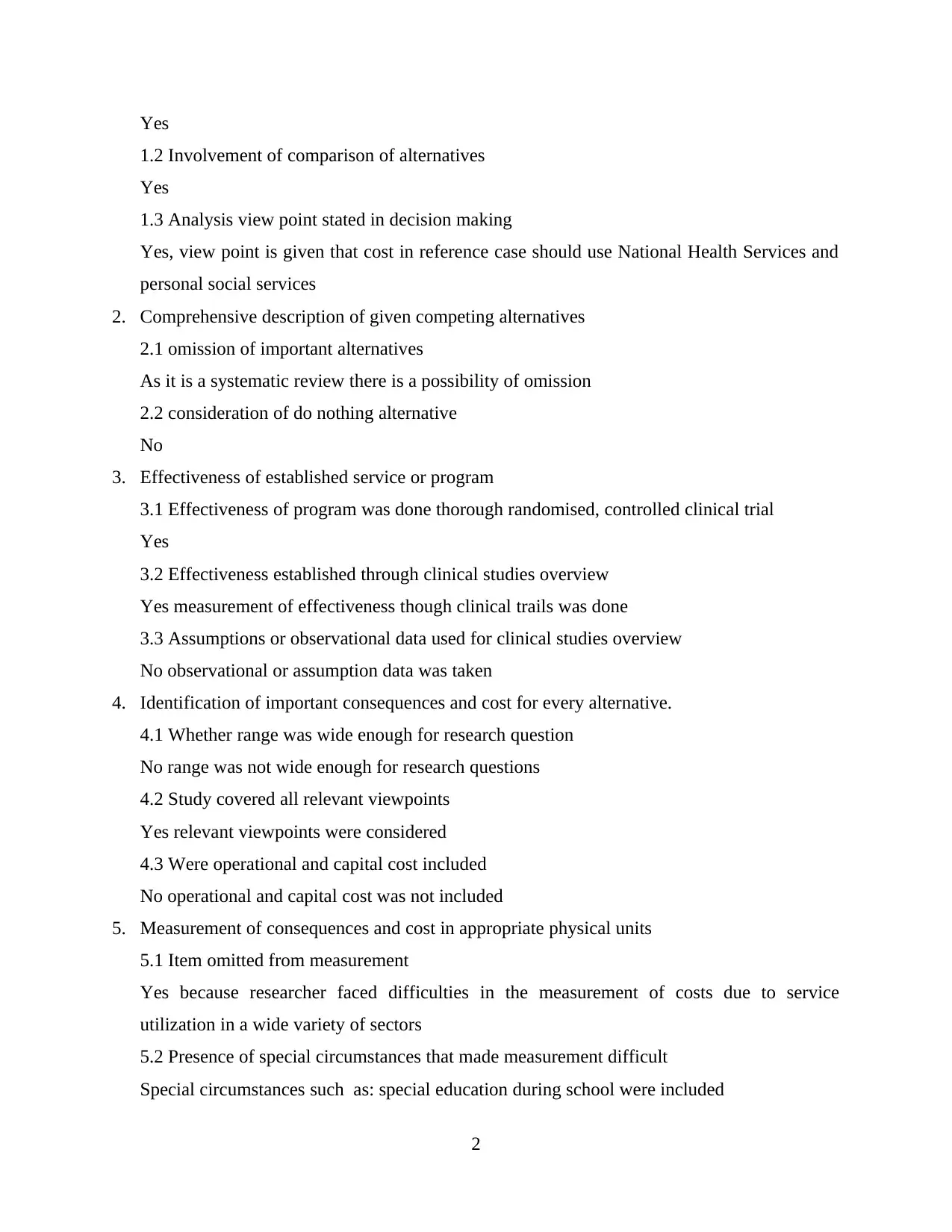
Yes
1.2 Involvement of comparison of alternatives
Yes
1.3 Analysis view point stated in decision making
Yes, view point is given that cost in reference case should use National Health Services and
personal social services
2. Comprehensive description of given competing alternatives
2.1 omission of important alternatives
As it is a systematic review there is a possibility of omission
2.2 consideration of do nothing alternative
No
3. Effectiveness of established service or program
3.1 Effectiveness of program was done thorough randomised, controlled clinical trial
Yes
3.2 Effectiveness established through clinical studies overview
Yes measurement of effectiveness though clinical trails was done
3.3 Assumptions or observational data used for clinical studies overview
No observational or assumption data was taken
4. Identification of important consequences and cost for every alternative.
4.1 Whether range was wide enough for research question
No range was not wide enough for research questions
4.2 Study covered all relevant viewpoints
Yes relevant viewpoints were considered
4.3 Were operational and capital cost included
No operational and capital cost was not included
5. Measurement of consequences and cost in appropriate physical units
5.1 Item omitted from measurement
Yes because researcher faced difficulties in the measurement of costs due to service
utilization in a wide variety of sectors
5.2 Presence of special circumstances that made measurement difficult
Special circumstances such as: special education during school were included
2
1.2 Involvement of comparison of alternatives
Yes
1.3 Analysis view point stated in decision making
Yes, view point is given that cost in reference case should use National Health Services and
personal social services
2. Comprehensive description of given competing alternatives
2.1 omission of important alternatives
As it is a systematic review there is a possibility of omission
2.2 consideration of do nothing alternative
No
3. Effectiveness of established service or program
3.1 Effectiveness of program was done thorough randomised, controlled clinical trial
Yes
3.2 Effectiveness established through clinical studies overview
Yes measurement of effectiveness though clinical trails was done
3.3 Assumptions or observational data used for clinical studies overview
No observational or assumption data was taken
4. Identification of important consequences and cost for every alternative.
4.1 Whether range was wide enough for research question
No range was not wide enough for research questions
4.2 Study covered all relevant viewpoints
Yes relevant viewpoints were considered
4.3 Were operational and capital cost included
No operational and capital cost was not included
5. Measurement of consequences and cost in appropriate physical units
5.1 Item omitted from measurement
Yes because researcher faced difficulties in the measurement of costs due to service
utilization in a wide variety of sectors
5.2 Presence of special circumstances that made measurement difficult
Special circumstances such as: special education during school were included
2
Paraphrase This Document
Need a fresh take? Get an instant paraphrase of this document with our AI Paraphraser
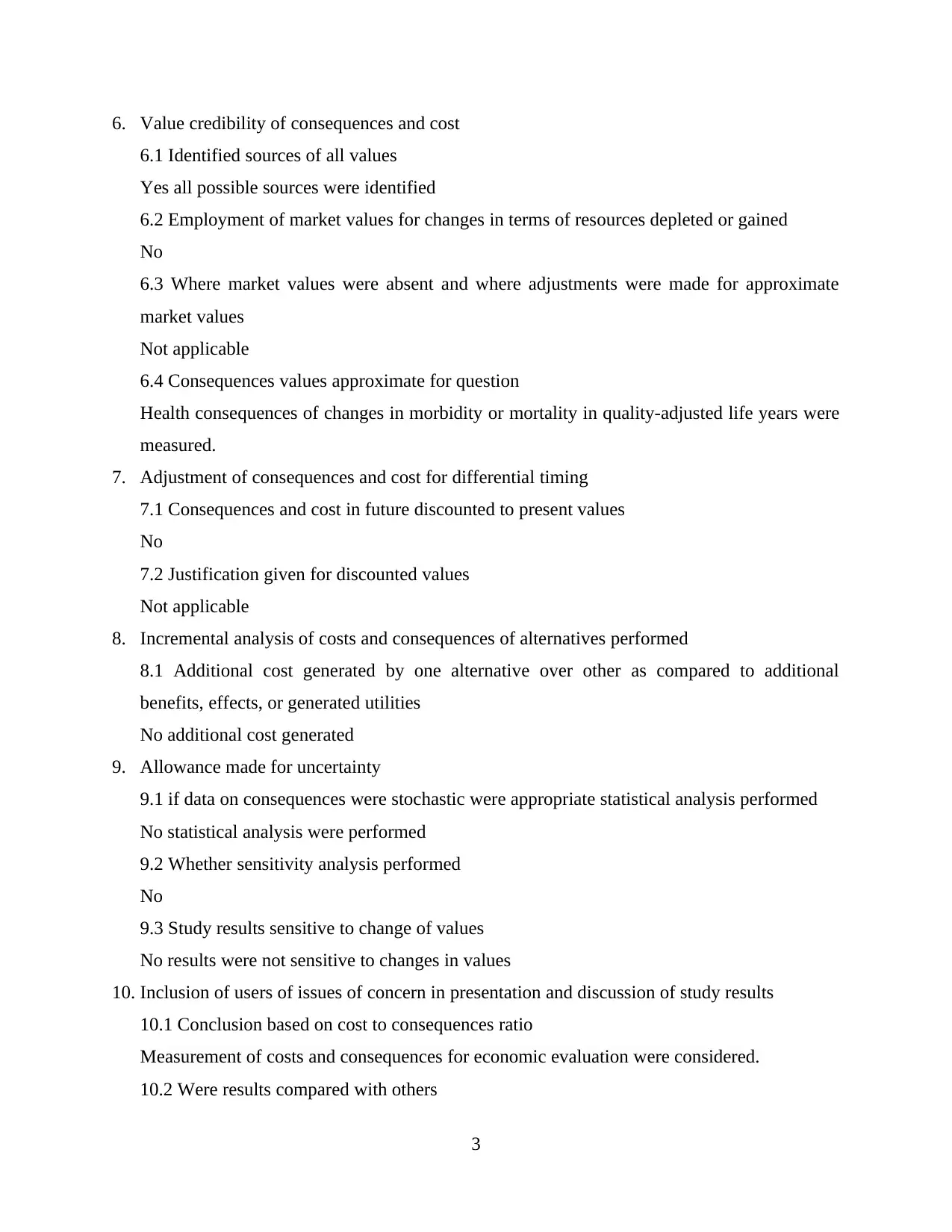
6. Value credibility of consequences and cost
6.1 Identified sources of all values
Yes all possible sources were identified
6.2 Employment of market values for changes in terms of resources depleted or gained
No
6.3 Where market values were absent and where adjustments were made for approximate
market values
Not applicable
6.4 Consequences values approximate for question
Health consequences of changes in morbidity or mortality in quality-adjusted life years were
measured.
7. Adjustment of consequences and cost for differential timing
7.1 Consequences and cost in future discounted to present values
No
7.2 Justification given for discounted values
Not applicable
8. Incremental analysis of costs and consequences of alternatives performed
8.1 Additional cost generated by one alternative over other as compared to additional
benefits, effects, or generated utilities
No additional cost generated
9. Allowance made for uncertainty
9.1 if data on consequences were stochastic were appropriate statistical analysis performed
No statistical analysis were performed
9.2 Whether sensitivity analysis performed
No
9.3 Study results sensitive to change of values
No results were not sensitive to changes in values
10. Inclusion of users of issues of concern in presentation and discussion of study results
10.1 Conclusion based on cost to consequences ratio
Measurement of costs and consequences for economic evaluation were considered.
10.2 Were results compared with others
3
6.1 Identified sources of all values
Yes all possible sources were identified
6.2 Employment of market values for changes in terms of resources depleted or gained
No
6.3 Where market values were absent and where adjustments were made for approximate
market values
Not applicable
6.4 Consequences values approximate for question
Health consequences of changes in morbidity or mortality in quality-adjusted life years were
measured.
7. Adjustment of consequences and cost for differential timing
7.1 Consequences and cost in future discounted to present values
No
7.2 Justification given for discounted values
Not applicable
8. Incremental analysis of costs and consequences of alternatives performed
8.1 Additional cost generated by one alternative over other as compared to additional
benefits, effects, or generated utilities
No additional cost generated
9. Allowance made for uncertainty
9.1 if data on consequences were stochastic were appropriate statistical analysis performed
No statistical analysis were performed
9.2 Whether sensitivity analysis performed
No
9.3 Study results sensitive to change of values
No results were not sensitive to changes in values
10. Inclusion of users of issues of concern in presentation and discussion of study results
10.1 Conclusion based on cost to consequences ratio
Measurement of costs and consequences for economic evaluation were considered.
10.2 Were results compared with others
3
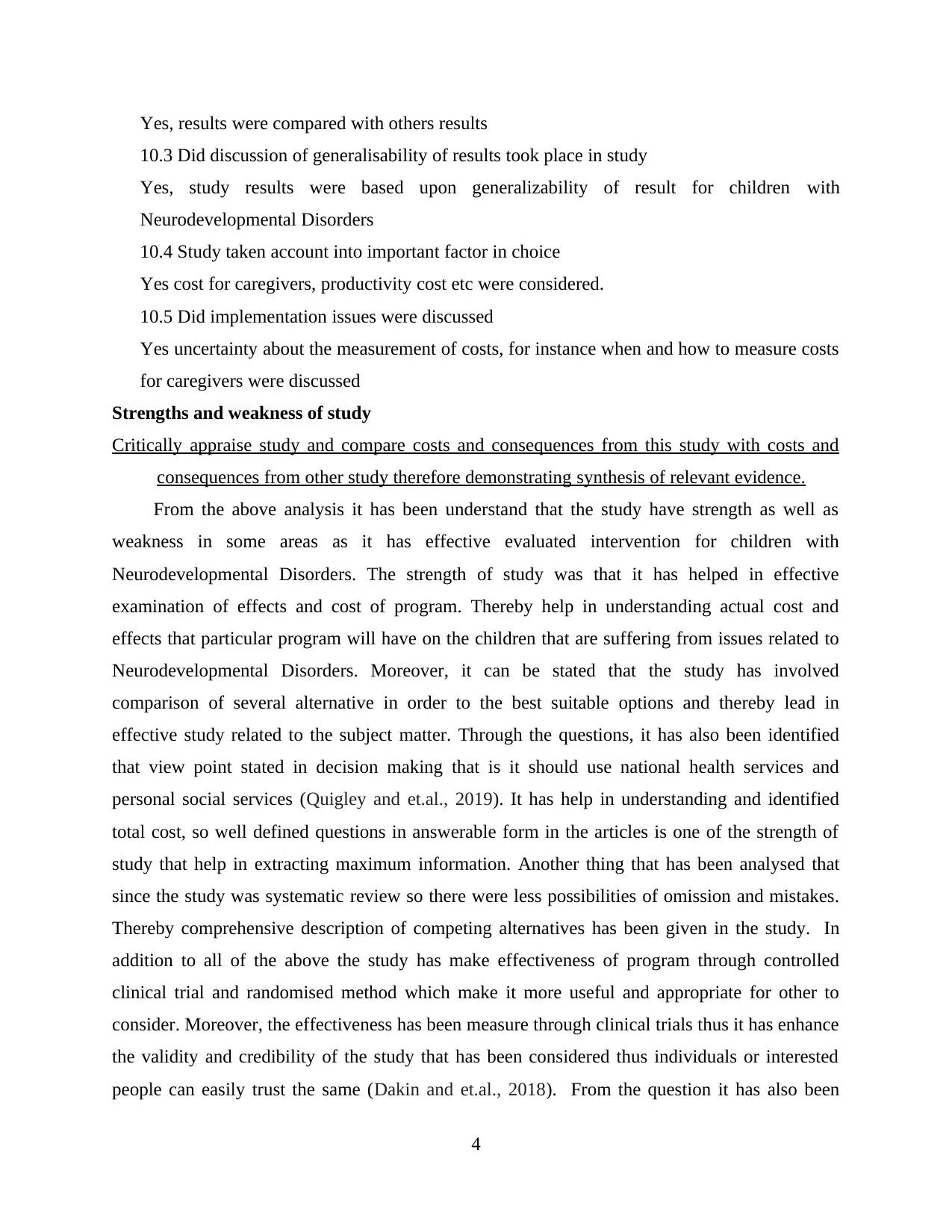
Yes, results were compared with others results
10.3 Did discussion of generalisability of results took place in study
Yes, study results were based upon generalizability of result for children with
Neurodevelopmental Disorders
10.4 Study taken account into important factor in choice
Yes cost for caregivers, productivity cost etc were considered.
10.5 Did implementation issues were discussed
Yes uncertainty about the measurement of costs, for instance when and how to measure costs
for caregivers were discussed
Strengths and weakness of study
Critically appraise study and compare costs and consequences from this study with costs and
consequences from other study therefore demonstrating synthesis of relevant evidence.
From the above analysis it has been understand that the study have strength as well as
weakness in some areas as it has effective evaluated intervention for children with
Neurodevelopmental Disorders. The strength of study was that it has helped in effective
examination of effects and cost of program. Thereby help in understanding actual cost and
effects that particular program will have on the children that are suffering from issues related to
Neurodevelopmental Disorders. Moreover, it can be stated that the study has involved
comparison of several alternative in order to the best suitable options and thereby lead in
effective study related to the subject matter. Through the questions, it has also been identified
that view point stated in decision making that is it should use national health services and
personal social services (Quigley and et.al., 2019). It has help in understanding and identified
total cost, so well defined questions in answerable form in the articles is one of the strength of
study that help in extracting maximum information. Another thing that has been analysed that
since the study was systematic review so there were less possibilities of omission and mistakes.
Thereby comprehensive description of competing alternatives has been given in the study. In
addition to all of the above the study has make effectiveness of program through controlled
clinical trial and randomised method which make it more useful and appropriate for other to
consider. Moreover, the effectiveness has been measure through clinical trials thus it has enhance
the validity and credibility of the study that has been considered thus individuals or interested
people can easily trust the same (Dakin and et.al., 2018). From the question it has also been
4
10.3 Did discussion of generalisability of results took place in study
Yes, study results were based upon generalizability of result for children with
Neurodevelopmental Disorders
10.4 Study taken account into important factor in choice
Yes cost for caregivers, productivity cost etc were considered.
10.5 Did implementation issues were discussed
Yes uncertainty about the measurement of costs, for instance when and how to measure costs
for caregivers were discussed
Strengths and weakness of study
Critically appraise study and compare costs and consequences from this study with costs and
consequences from other study therefore demonstrating synthesis of relevant evidence.
From the above analysis it has been understand that the study have strength as well as
weakness in some areas as it has effective evaluated intervention for children with
Neurodevelopmental Disorders. The strength of study was that it has helped in effective
examination of effects and cost of program. Thereby help in understanding actual cost and
effects that particular program will have on the children that are suffering from issues related to
Neurodevelopmental Disorders. Moreover, it can be stated that the study has involved
comparison of several alternative in order to the best suitable options and thereby lead in
effective study related to the subject matter. Through the questions, it has also been identified
that view point stated in decision making that is it should use national health services and
personal social services (Quigley and et.al., 2019). It has help in understanding and identified
total cost, so well defined questions in answerable form in the articles is one of the strength of
study that help in extracting maximum information. Another thing that has been analysed that
since the study was systematic review so there were less possibilities of omission and mistakes.
Thereby comprehensive description of competing alternatives has been given in the study. In
addition to all of the above the study has make effectiveness of program through controlled
clinical trial and randomised method which make it more useful and appropriate for other to
consider. Moreover, the effectiveness has been measure through clinical trials thus it has enhance
the validity and credibility of the study that has been considered thus individuals or interested
people can easily trust the same (Dakin and et.al., 2018). From the question it has also been
4
⊘ This is a preview!⊘
Do you want full access?
Subscribe today to unlock all pages.

Trusted by 1+ million students worldwide
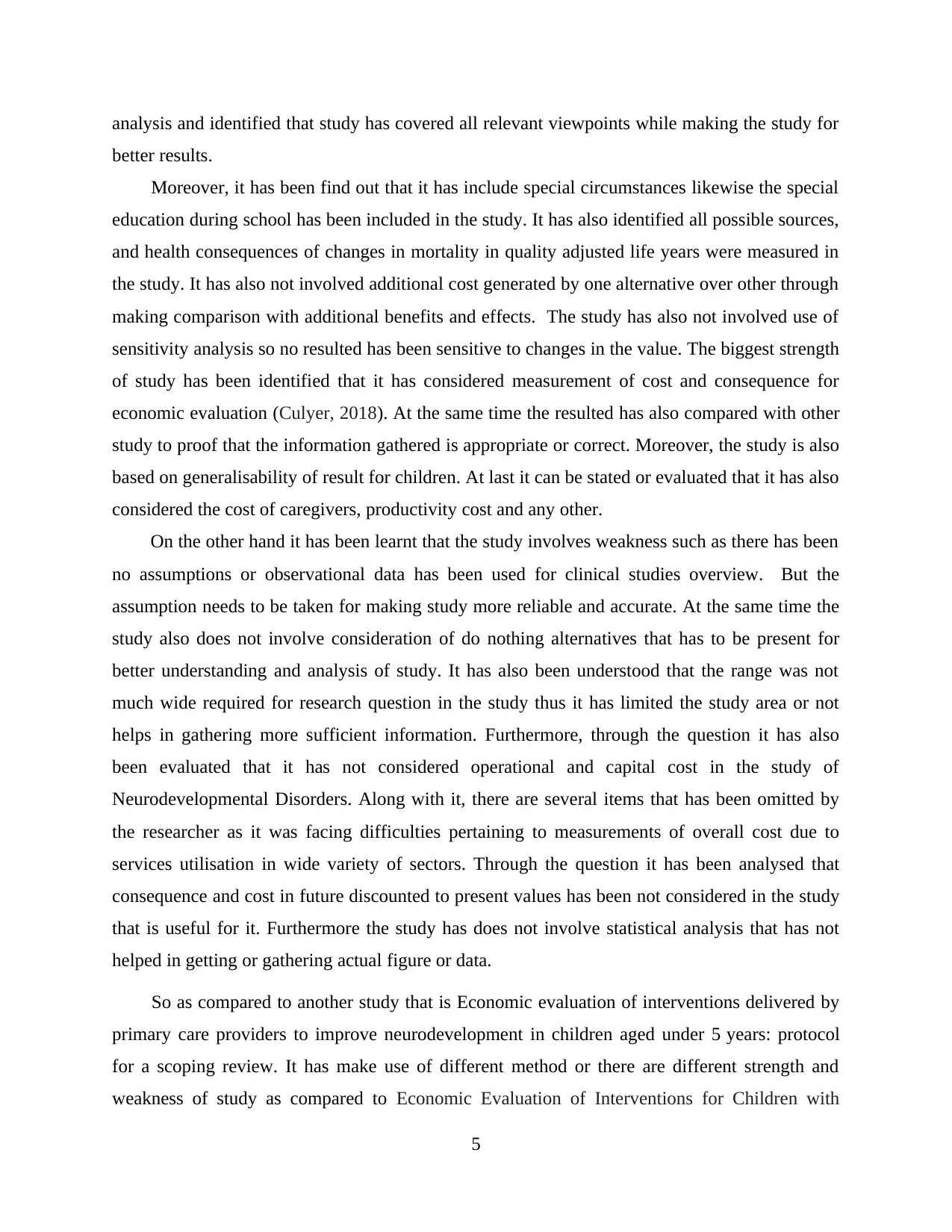
analysis and identified that study has covered all relevant viewpoints while making the study for
better results.
Moreover, it has been find out that it has include special circumstances likewise the special
education during school has been included in the study. It has also identified all possible sources,
and health consequences of changes in mortality in quality adjusted life years were measured in
the study. It has also not involved additional cost generated by one alternative over other through
making comparison with additional benefits and effects. The study has also not involved use of
sensitivity analysis so no resulted has been sensitive to changes in the value. The biggest strength
of study has been identified that it has considered measurement of cost and consequence for
economic evaluation (Culyer, 2018). At the same time the resulted has also compared with other
study to proof that the information gathered is appropriate or correct. Moreover, the study is also
based on generalisability of result for children. At last it can be stated or evaluated that it has also
considered the cost of caregivers, productivity cost and any other.
On the other hand it has been learnt that the study involves weakness such as there has been
no assumptions or observational data has been used for clinical studies overview. But the
assumption needs to be taken for making study more reliable and accurate. At the same time the
study also does not involve consideration of do nothing alternatives that has to be present for
better understanding and analysis of study. It has also been understood that the range was not
much wide required for research question in the study thus it has limited the study area or not
helps in gathering more sufficient information. Furthermore, through the question it has also
been evaluated that it has not considered operational and capital cost in the study of
Neurodevelopmental Disorders. Along with it, there are several items that has been omitted by
the researcher as it was facing difficulties pertaining to measurements of overall cost due to
services utilisation in wide variety of sectors. Through the question it has been analysed that
consequence and cost in future discounted to present values has been not considered in the study
that is useful for it. Furthermore the study has does not involve statistical analysis that has not
helped in getting or gathering actual figure or data.
So as compared to another study that is Economic evaluation of interventions delivered by
primary care providers to improve neurodevelopment in children aged under 5 years: protocol
for a scoping review. It has make use of different method or there are different strength and
weakness of study as compared to Economic Evaluation of Interventions for Children with
5
better results.
Moreover, it has been find out that it has include special circumstances likewise the special
education during school has been included in the study. It has also identified all possible sources,
and health consequences of changes in mortality in quality adjusted life years were measured in
the study. It has also not involved additional cost generated by one alternative over other through
making comparison with additional benefits and effects. The study has also not involved use of
sensitivity analysis so no resulted has been sensitive to changes in the value. The biggest strength
of study has been identified that it has considered measurement of cost and consequence for
economic evaluation (Culyer, 2018). At the same time the resulted has also compared with other
study to proof that the information gathered is appropriate or correct. Moreover, the study is also
based on generalisability of result for children. At last it can be stated or evaluated that it has also
considered the cost of caregivers, productivity cost and any other.
On the other hand it has been learnt that the study involves weakness such as there has been
no assumptions or observational data has been used for clinical studies overview. But the
assumption needs to be taken for making study more reliable and accurate. At the same time the
study also does not involve consideration of do nothing alternatives that has to be present for
better understanding and analysis of study. It has also been understood that the range was not
much wide required for research question in the study thus it has limited the study area or not
helps in gathering more sufficient information. Furthermore, through the question it has also
been evaluated that it has not considered operational and capital cost in the study of
Neurodevelopmental Disorders. Along with it, there are several items that has been omitted by
the researcher as it was facing difficulties pertaining to measurements of overall cost due to
services utilisation in wide variety of sectors. Through the question it has been analysed that
consequence and cost in future discounted to present values has been not considered in the study
that is useful for it. Furthermore the study has does not involve statistical analysis that has not
helped in getting or gathering actual figure or data.
So as compared to another study that is Economic evaluation of interventions delivered by
primary care providers to improve neurodevelopment in children aged under 5 years: protocol
for a scoping review. It has make use of different method or there are different strength and
weakness of study as compared to Economic Evaluation of Interventions for Children with
5
Paraphrase This Document
Need a fresh take? Get an instant paraphrase of this document with our AI Paraphraser
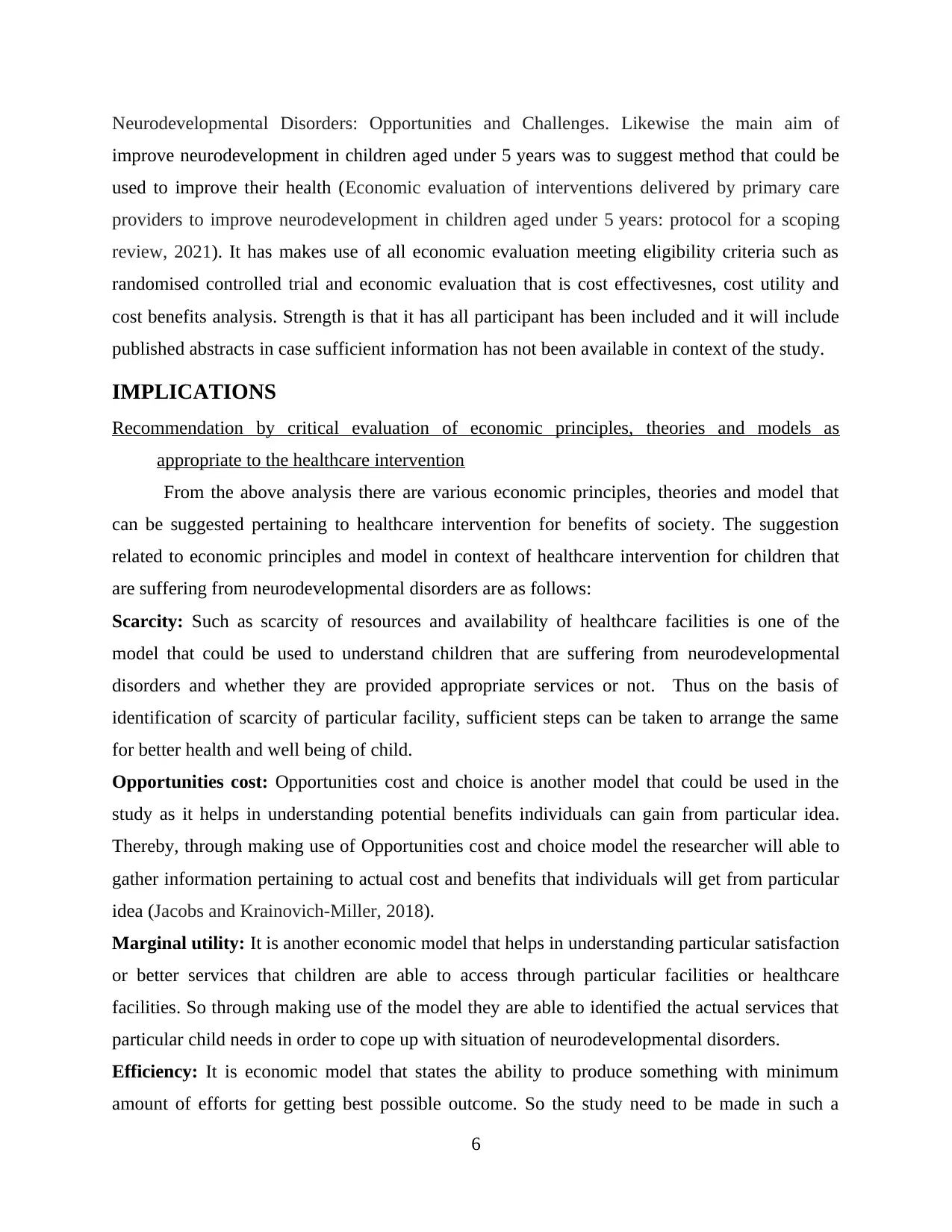
Neurodevelopmental Disorders: Opportunities and Challenges. Likewise the main aim of
improve neurodevelopment in children aged under 5 years was to suggest method that could be
used to improve their health (Economic evaluation of interventions delivered by primary care
providers to improve neurodevelopment in children aged under 5 years: protocol for a scoping
review, 2021). It has makes use of all economic evaluation meeting eligibility criteria such as
randomised controlled trial and economic evaluation that is cost effectivesnes, cost utility and
cost benefits analysis. Strength is that it has all participant has been included and it will include
published abstracts in case sufficient information has not been available in context of the study.
IMPLICATIONS
Recommendation by critical evaluation of economic principles, theories and models as
appropriate to the healthcare intervention
From the above analysis there are various economic principles, theories and model that
can be suggested pertaining to healthcare intervention for benefits of society. The suggestion
related to economic principles and model in context of healthcare intervention for children that
are suffering from neurodevelopmental disorders are as follows:
Scarcity: Such as scarcity of resources and availability of healthcare facilities is one of the
model that could be used to understand children that are suffering from neurodevelopmental
disorders and whether they are provided appropriate services or not. Thus on the basis of
identification of scarcity of particular facility, sufficient steps can be taken to arrange the same
for better health and well being of child.
Opportunities cost: Opportunities cost and choice is another model that could be used in the
study as it helps in understanding potential benefits individuals can gain from particular idea.
Thereby, through making use of Opportunities cost and choice model the researcher will able to
gather information pertaining to actual cost and benefits that individuals will get from particular
idea (Jacobs and Krainovich-Miller, 2018).
Marginal utility: It is another economic model that helps in understanding particular satisfaction
or better services that children are able to access through particular facilities or healthcare
facilities. So through making use of the model they are able to identified the actual services that
particular child needs in order to cope up with situation of neurodevelopmental disorders.
Efficiency: It is economic model that states the ability to produce something with minimum
amount of efforts for getting best possible outcome. So the study need to be made in such a
6
improve neurodevelopment in children aged under 5 years was to suggest method that could be
used to improve their health (Economic evaluation of interventions delivered by primary care
providers to improve neurodevelopment in children aged under 5 years: protocol for a scoping
review, 2021). It has makes use of all economic evaluation meeting eligibility criteria such as
randomised controlled trial and economic evaluation that is cost effectivesnes, cost utility and
cost benefits analysis. Strength is that it has all participant has been included and it will include
published abstracts in case sufficient information has not been available in context of the study.
IMPLICATIONS
Recommendation by critical evaluation of economic principles, theories and models as
appropriate to the healthcare intervention
From the above analysis there are various economic principles, theories and model that
can be suggested pertaining to healthcare intervention for benefits of society. The suggestion
related to economic principles and model in context of healthcare intervention for children that
are suffering from neurodevelopmental disorders are as follows:
Scarcity: Such as scarcity of resources and availability of healthcare facilities is one of the
model that could be used to understand children that are suffering from neurodevelopmental
disorders and whether they are provided appropriate services or not. Thus on the basis of
identification of scarcity of particular facility, sufficient steps can be taken to arrange the same
for better health and well being of child.
Opportunities cost: Opportunities cost and choice is another model that could be used in the
study as it helps in understanding potential benefits individuals can gain from particular idea.
Thereby, through making use of Opportunities cost and choice model the researcher will able to
gather information pertaining to actual cost and benefits that individuals will get from particular
idea (Jacobs and Krainovich-Miller, 2018).
Marginal utility: It is another economic model that helps in understanding particular satisfaction
or better services that children are able to access through particular facilities or healthcare
facilities. So through making use of the model they are able to identified the actual services that
particular child needs in order to cope up with situation of neurodevelopmental disorders.
Efficiency: It is economic model that states the ability to produce something with minimum
amount of efforts for getting best possible outcome. So the study need to be made in such a
6
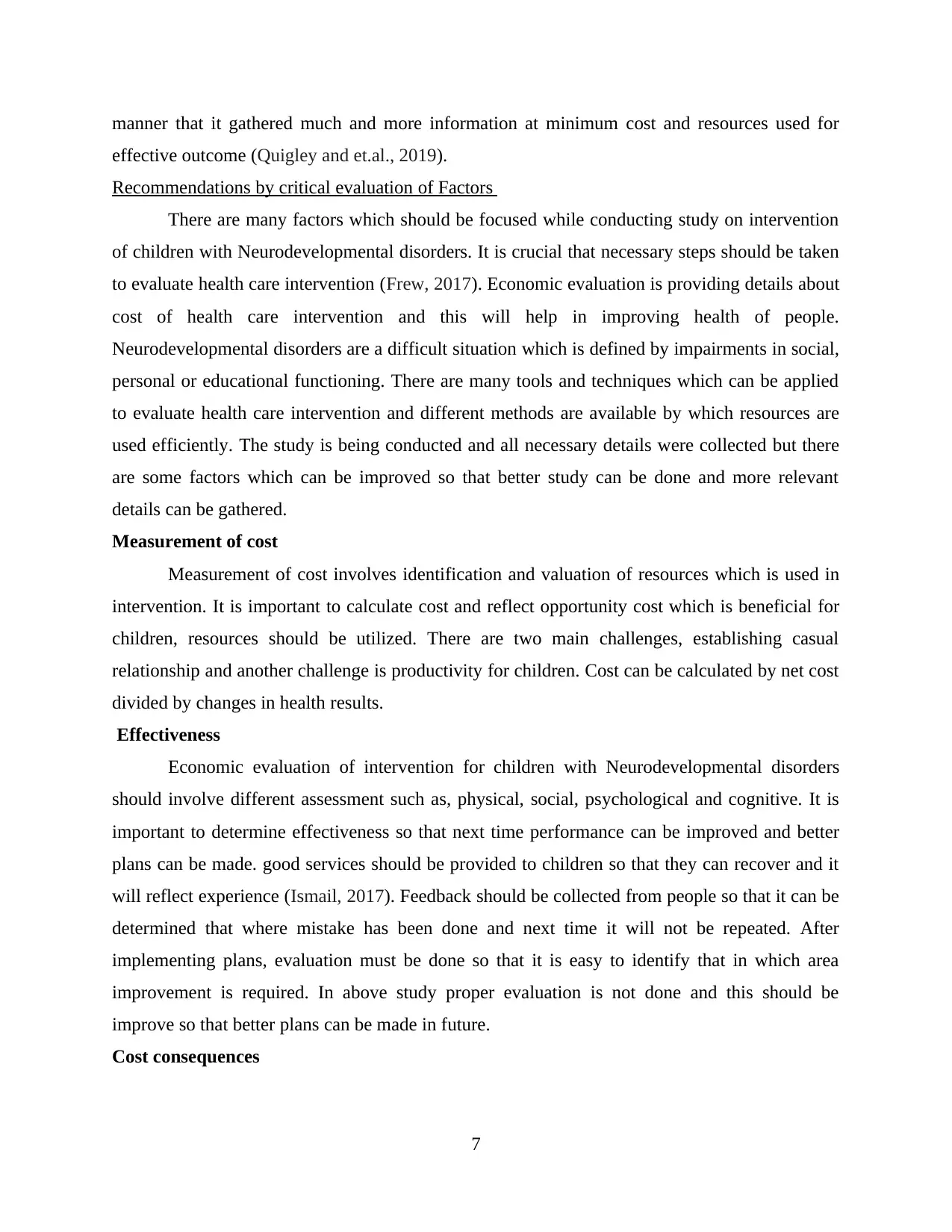
manner that it gathered much and more information at minimum cost and resources used for
effective outcome (Quigley and et.al., 2019).
Recommendations by critical evaluation of Factors
There are many factors which should be focused while conducting study on intervention
of children with Neurodevelopmental disorders. It is crucial that necessary steps should be taken
to evaluate health care intervention (Frew, 2017). Economic evaluation is providing details about
cost of health care intervention and this will help in improving health of people.
Neurodevelopmental disorders are a difficult situation which is defined by impairments in social,
personal or educational functioning. There are many tools and techniques which can be applied
to evaluate health care intervention and different methods are available by which resources are
used efficiently. The study is being conducted and all necessary details were collected but there
are some factors which can be improved so that better study can be done and more relevant
details can be gathered.
Measurement of cost
Measurement of cost involves identification and valuation of resources which is used in
intervention. It is important to calculate cost and reflect opportunity cost which is beneficial for
children, resources should be utilized. There are two main challenges, establishing casual
relationship and another challenge is productivity for children. Cost can be calculated by net cost
divided by changes in health results.
Effectiveness
Economic evaluation of intervention for children with Neurodevelopmental disorders
should involve different assessment such as, physical, social, psychological and cognitive. It is
important to determine effectiveness so that next time performance can be improved and better
plans can be made. good services should be provided to children so that they can recover and it
will reflect experience (Ismail, 2017). Feedback should be collected from people so that it can be
determined that where mistake has been done and next time it will not be repeated. After
implementing plans, evaluation must be done so that it is easy to identify that in which area
improvement is required. In above study proper evaluation is not done and this should be
improve so that better plans can be made in future.
Cost consequences
7
effective outcome (Quigley and et.al., 2019).
Recommendations by critical evaluation of Factors
There are many factors which should be focused while conducting study on intervention
of children with Neurodevelopmental disorders. It is crucial that necessary steps should be taken
to evaluate health care intervention (Frew, 2017). Economic evaluation is providing details about
cost of health care intervention and this will help in improving health of people.
Neurodevelopmental disorders are a difficult situation which is defined by impairments in social,
personal or educational functioning. There are many tools and techniques which can be applied
to evaluate health care intervention and different methods are available by which resources are
used efficiently. The study is being conducted and all necessary details were collected but there
are some factors which can be improved so that better study can be done and more relevant
details can be gathered.
Measurement of cost
Measurement of cost involves identification and valuation of resources which is used in
intervention. It is important to calculate cost and reflect opportunity cost which is beneficial for
children, resources should be utilized. There are two main challenges, establishing casual
relationship and another challenge is productivity for children. Cost can be calculated by net cost
divided by changes in health results.
Effectiveness
Economic evaluation of intervention for children with Neurodevelopmental disorders
should involve different assessment such as, physical, social, psychological and cognitive. It is
important to determine effectiveness so that next time performance can be improved and better
plans can be made. good services should be provided to children so that they can recover and it
will reflect experience (Ismail, 2017). Feedback should be collected from people so that it can be
determined that where mistake has been done and next time it will not be repeated. After
implementing plans, evaluation must be done so that it is easy to identify that in which area
improvement is required. In above study proper evaluation is not done and this should be
improve so that better plans can be made in future.
Cost consequences
7
⊘ This is a preview!⊘
Do you want full access?
Subscribe today to unlock all pages.

Trusted by 1+ million students worldwide
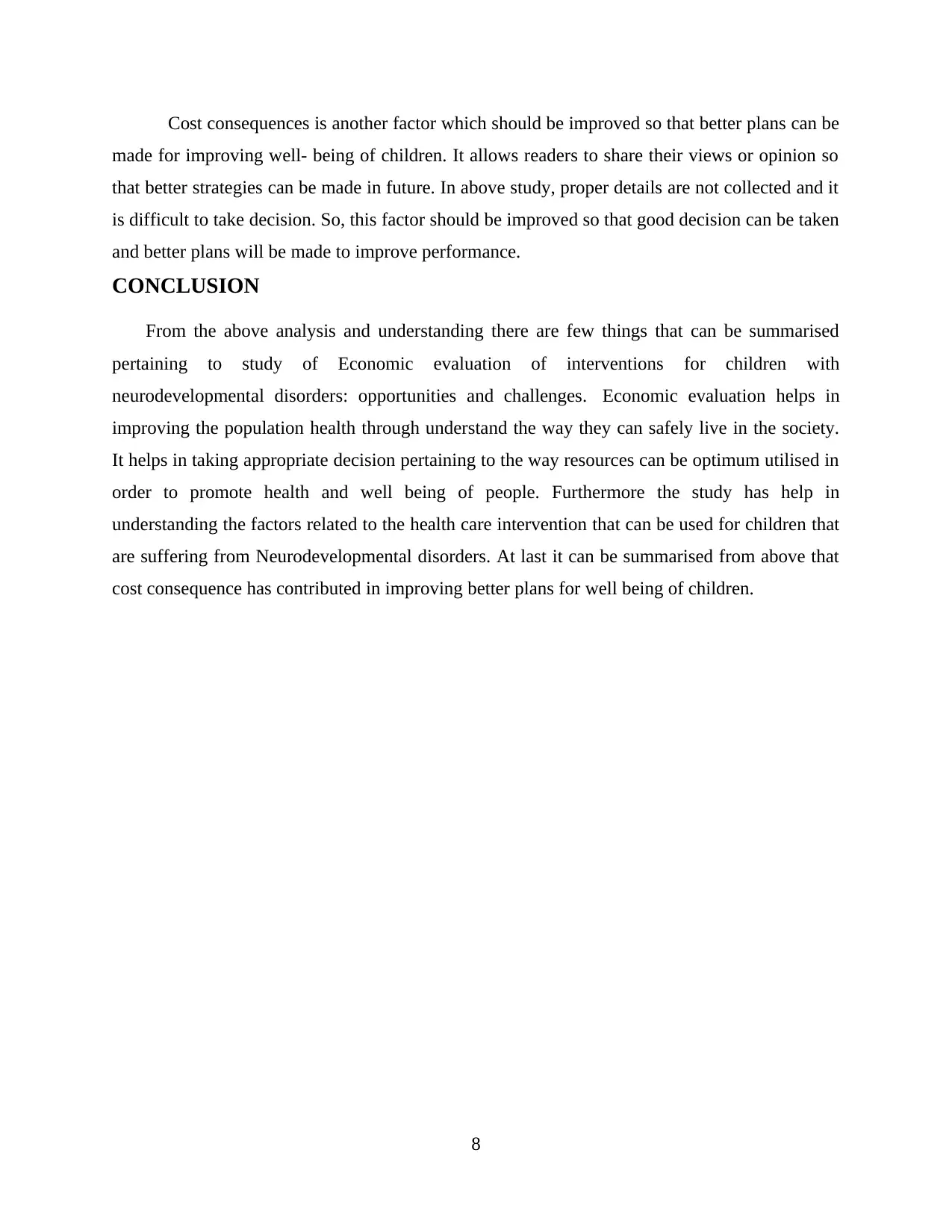
Cost consequences is another factor which should be improved so that better plans can be
made for improving well- being of children. It allows readers to share their views or opinion so
that better strategies can be made in future. In above study, proper details are not collected and it
is difficult to take decision. So, this factor should be improved so that good decision can be taken
and better plans will be made to improve performance.
CONCLUSION
From the above analysis and understanding there are few things that can be summarised
pertaining to study of Economic evaluation of interventions for children with
neurodevelopmental disorders: opportunities and challenges. Economic evaluation helps in
improving the population health through understand the way they can safely live in the society.
It helps in taking appropriate decision pertaining to the way resources can be optimum utilised in
order to promote health and well being of people. Furthermore the study has help in
understanding the factors related to the health care intervention that can be used for children that
are suffering from Neurodevelopmental disorders. At last it can be summarised from above that
cost consequence has contributed in improving better plans for well being of children.
8
made for improving well- being of children. It allows readers to share their views or opinion so
that better strategies can be made in future. In above study, proper details are not collected and it
is difficult to take decision. So, this factor should be improved so that good decision can be taken
and better plans will be made to improve performance.
CONCLUSION
From the above analysis and understanding there are few things that can be summarised
pertaining to study of Economic evaluation of interventions for children with
neurodevelopmental disorders: opportunities and challenges. Economic evaluation helps in
improving the population health through understand the way they can safely live in the society.
It helps in taking appropriate decision pertaining to the way resources can be optimum utilised in
order to promote health and well being of people. Furthermore the study has help in
understanding the factors related to the health care intervention that can be used for children that
are suffering from Neurodevelopmental disorders. At last it can be summarised from above that
cost consequence has contributed in improving better plans for well being of children.
8
Paraphrase This Document
Need a fresh take? Get an instant paraphrase of this document with our AI Paraphraser
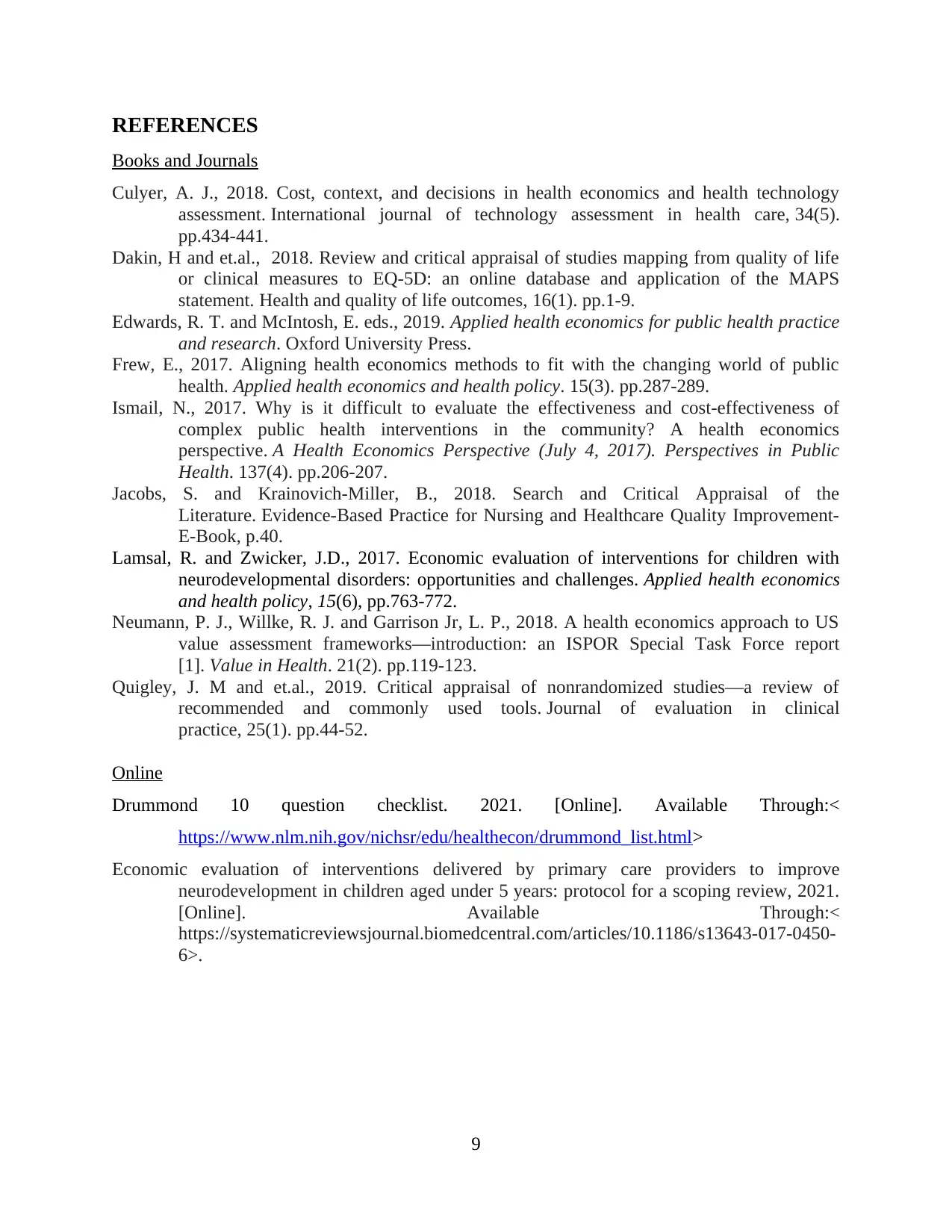
REFERENCES
Books and Journals
Culyer, A. J., 2018. Cost, context, and decisions in health economics and health technology
assessment. International journal of technology assessment in health care, 34(5).
pp.434-441.
Dakin, H and et.al., 2018. Review and critical appraisal of studies mapping from quality of life
or clinical measures to EQ-5D: an online database and application of the MAPS
statement. Health and quality of life outcomes, 16(1). pp.1-9.
Edwards, R. T. and McIntosh, E. eds., 2019. Applied health economics for public health practice
and research. Oxford University Press.
Frew, E., 2017. Aligning health economics methods to fit with the changing world of public
health. Applied health economics and health policy. 15(3). pp.287-289.
Ismail, N., 2017. Why is it difficult to evaluate the effectiveness and cost-effectiveness of
complex public health interventions in the community? A health economics
perspective. A Health Economics Perspective (July 4, 2017). Perspectives in Public
Health. 137(4). pp.206-207.
Jacobs, S. and Krainovich-Miller, B., 2018. Search and Critical Appraisal of the
Literature. Evidence-Based Practice for Nursing and Healthcare Quality Improvement-
E-Book, p.40.
Lamsal, R. and Zwicker, J.D., 2017. Economic evaluation of interventions for children with
neurodevelopmental disorders: opportunities and challenges. Applied health economics
and health policy, 15(6), pp.763-772.
Neumann, P. J., Willke, R. J. and Garrison Jr, L. P., 2018. A health economics approach to US
value assessment frameworks—introduction: an ISPOR Special Task Force report
[1]. Value in Health. 21(2). pp.119-123.
Quigley, J. M and et.al., 2019. Critical appraisal of nonrandomized studies—a review of
recommended and commonly used tools. Journal of evaluation in clinical
practice, 25(1). pp.44-52.
Online
Drummond 10 question checklist. 2021. [Online]. Available Through:<
https://www.nlm.nih.gov/nichsr/edu/healthecon/drummond_list.html>
Economic evaluation of interventions delivered by primary care providers to improve
neurodevelopment in children aged under 5 years: protocol for a scoping review, 2021.
[Online]. Available Through:<
https://systematicreviewsjournal.biomedcentral.com/articles/10.1186/s13643-017-0450-
6>.
9
Books and Journals
Culyer, A. J., 2018. Cost, context, and decisions in health economics and health technology
assessment. International journal of technology assessment in health care, 34(5).
pp.434-441.
Dakin, H and et.al., 2018. Review and critical appraisal of studies mapping from quality of life
or clinical measures to EQ-5D: an online database and application of the MAPS
statement. Health and quality of life outcomes, 16(1). pp.1-9.
Edwards, R. T. and McIntosh, E. eds., 2019. Applied health economics for public health practice
and research. Oxford University Press.
Frew, E., 2017. Aligning health economics methods to fit with the changing world of public
health. Applied health economics and health policy. 15(3). pp.287-289.
Ismail, N., 2017. Why is it difficult to evaluate the effectiveness and cost-effectiveness of
complex public health interventions in the community? A health economics
perspective. A Health Economics Perspective (July 4, 2017). Perspectives in Public
Health. 137(4). pp.206-207.
Jacobs, S. and Krainovich-Miller, B., 2018. Search and Critical Appraisal of the
Literature. Evidence-Based Practice for Nursing and Healthcare Quality Improvement-
E-Book, p.40.
Lamsal, R. and Zwicker, J.D., 2017. Economic evaluation of interventions for children with
neurodevelopmental disorders: opportunities and challenges. Applied health economics
and health policy, 15(6), pp.763-772.
Neumann, P. J., Willke, R. J. and Garrison Jr, L. P., 2018. A health economics approach to US
value assessment frameworks—introduction: an ISPOR Special Task Force report
[1]. Value in Health. 21(2). pp.119-123.
Quigley, J. M and et.al., 2019. Critical appraisal of nonrandomized studies—a review of
recommended and commonly used tools. Journal of evaluation in clinical
practice, 25(1). pp.44-52.
Online
Drummond 10 question checklist. 2021. [Online]. Available Through:<
https://www.nlm.nih.gov/nichsr/edu/healthecon/drummond_list.html>
Economic evaluation of interventions delivered by primary care providers to improve
neurodevelopment in children aged under 5 years: protocol for a scoping review, 2021.
[Online]. Available Through:<
https://systematicreviewsjournal.biomedcentral.com/articles/10.1186/s13643-017-0450-
6>.
9
1 out of 11
Related Documents
Your All-in-One AI-Powered Toolkit for Academic Success.
+13062052269
info@desklib.com
Available 24*7 on WhatsApp / Email
![[object Object]](/_next/static/media/star-bottom.7253800d.svg)
Unlock your academic potential
Copyright © 2020–2025 A2Z Services. All Rights Reserved. Developed and managed by ZUCOL.





